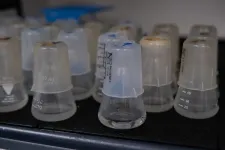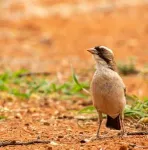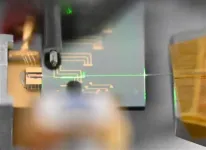(Press-News.org) As conceived by Charles Darwin in the 1800s, evolution is a slow, gradual process during which species adaptations are inherited incrementally over generations. However, today biologists can see how evolutionary changes unfold on much more accelerated timescales.
Rather than the evocative plants and animals of the Galapagos Islands that Darwin studied in forming his theory of evolution, Postdoctoral Scholar Joshua Borin and Associate Professor Justin Meyer of UC San Diego’s School of Biological Sciences are documenting rapid evolutionary processes in simple laboratory flasks.
Borin and Meyer set bacteria and viruses together in a closed laboratory flask — just two teaspoons large — to study coevolution in action. As viruses infect their bacterial neighbors, the bacteria evolve new defensive measures to repel the attacks. The viruses then counter these adaptations with their own evolutionary changes that work around the new defensive measures.
In only three weeks, this accelerated arms race between bacteria (Escherichia coli) and viruses (bacteriophage, or “phage”) results in several generations of evolutionary adaptations. The new findings, published in the journal Science, reveal the emergence of distinct evolutionary patterns.
“In this study we show the power of evolution,” said Meyer, an associate professor in the Department of Ecology, Behavior and Evolution. “We see how coevolution between bacteria and phage drive the emergence of a highly complicated ecological network. Evolution doesn’t have to be slow and gradual as Darwin thought.”
Meyer says the new study offers fresh perspectives on how intricate ecological networks develop across disparate ecosystems, whether they are food webs across the savanna, pollinator networks in the rainforest or microbes interacting in the ocean.
As bacteria and viruses adapted to each other’s presence over time, two prominent repeating patterns emerged. These included nestedness, a development in which narrow interactions between bacteria and virus specialists are “nested” within a broader range of generalist interactions; and modularity, in which interactions between species form modules within specialized groups, but not between groups.
“We were amazed to discover that our evolution experiment in tiny flasks had recapitulated the complex patterns that had been previously observed between bacteria and viruses collected at regional and transoceanic scales,” said Borin.
“When our research team first quantified this multiscale pattern in environmental bacteria and phage interaction data, we thought the emergence of such complexity required long periods of evolution,” added study coauthor Professor Joshua Weitz from the Department of Biology at the University of Maryland.
Meyer says capturing these evolutionary developments “in action” reinforces the power of evolution, which is often underestimated. Rapid pathogenic evolution continues to shape our world in new ways. Through COVID-19 and new mutations of SARS-CoV-2, viruses have demonstrated the potent capability for evolutionary adaptations that result in new strains when they encounter antibodies, vaccines and other roadblocks that keep them from effectively infecting and spreading. Such new concepts in microbial evolution are reframing the way patients are treated.
“We show that evolution can produce complex ecological networks quickly from very little external help,” said Meyer, who indicated that examples of such external evolutionary forces include isolation via geographical distance, environmental drivers and interactions with other species. “So we can use phage and bacteria as a model system to understand general evolutionary principles and help show how life on Earth has evolved into such diverse and complex ecosystems from simple beginnings.”
In related work, Meyer and Weitz are using artificial intelligence to study how phage could be used in the growing antibiotic resistance crisis. The research includes analysis of evolutionary data to determine which mutations in phage and bacteria can lead to infection and resistance. The research also highlights a new effort supported by the Howard Hughes Medical Institute to study how “jumbo” phages could be used as new therapeutic agents.
Coauthors of the Science paper include Joshua Borin, Justin Lee, Adriana Lucia-Sanz, Krista Gerbino, Joshua Weitz and Justin Meyer.
END
Bacteria-virus arms race provides rare window into rapid and complex evolution
Intricate ecological networks emerge from simple beginnings that feature repeating patterns of evolutionary development
2023-11-09
ELSE PRESS RELEASES FROM THIS DATE:
Open-science “COVID Moonshot” discovers new antivirals to treat COVID-19
2023-11-09
Although the group’s work has been freely available since its inception in March 2020, the COVID Moonshot Consortium is finally formally reporting their results. The COVID Moonshot – an open-science, crowdsourced, and patent-free drug discovery campaign targeting the SARS-CoV-2 virus – has yielded a wealth of data on the virus’s main protease, including insights that could pave the way for the development of new and better therapeutics. “The lead therapeutics described by [these researchers] may not be ready in time to affect the current pandemic, considering the timelines and challenges of drug approval,” write Brian Shoichet and Charles ...
Shrinking a mode-locked laser to the size of an optical chip
2023-11-09
Setting out to improve a technology that usually requires bulky, bench-top equipment, Quishi Guo and colleagues have shrunk a mode-locked laser (MLL) to the size of an optical chip with an integrated nanophotonic platform. The results show promise for developing ultrafast nanophotonic systems for a wide range of applications. Mode-locked lasers (MLLs) can produce coherent ultrashort pulses of light at extremely fast speeds – on the order of picoseconds and femtoseconds. These devices have enabled numerous technologies in photonics, including extreme nonlinear optics, two-photon microscopy, ...
Wildfire risk to US homes is rising, especially in western grasslands and shrublands
2023-11-09
Drawing on 30 years of data, researchers show that the number of homes within wildfire perimeters in the U.S. has doubled since the 1990s. This increasing risk is driven by both an increase in wildfires and the expansion of new homes into wildfire-prone areas, especially in the wildland-urban interface. Wildfire risks to homes are increasing, particularly in the wildland-urban interface (WUI), where houses and wildland vegetation are in close proximity. Over the last 12 years, more than 55,000 homes in the U.S. have been lost to wildfires due to rapid increases ...
Introducing: Ceramic- and glass-based passive radiative cooling materials resistance to harsh environments
2023-11-09
Two studies highlight new glass- and ceramic-based passive radiative cooling materials. Unlike passive radiative cooling approaches that rely on polymers, these hard materials are more durable and versatile, making them more attractive for a wide range of outdoor passive cooling applications, including those that could help reduce the need for air conditioning. The energy demand for cooling continues to rise, particularly in regions rapidly warming due to climate change. To make matters worse, the growing carbon footprint of cooling systems further contributes to global warming, exacerbating the need for cooling solutions. Passive radiative cooling (PRC) materials, which ...
Researchers identify previously unknown step in cholesterol absorption in the gut
2023-11-09
UCLA researchers have described a previously unknown step in the complex process by which dietary cholesterol is processed in the intestines before being released into the bloodstream – potentially revealing a new pathway to target in cholesterol treatment.
Although an existing drug and statins impact part of the process, an experimental drug being studied in UCLA research labs appears to specifically target the newfound pathway, possibly adding a new approach to the cholesterol management toolbox.
“Our results show that certain proteins in the Aster family play a critical role in moving cholesterol through the absorption and uptake process,” said ...
Desert birds lay larger eggs when they have more helpers
2023-11-09
Desert birds lay larger eggs when they have more helpers to feed their chicks, new research shows.
White-browed sparrow weavers live in family groups in which only a dominant pair breeds and their grown-up offspring, particularly females, help to feed nestlings.
The study, by researchers at the University of Exeter, found that mothers increased the size of their eggs when they had more female helpers on hand.
The number of male helpers did not affect egg size, probably because male helpers feed chicks at substantially lower rates than female helpers.
“We don’t yet fully understand why helped mothers are laying heavier ...
Ethical, environmental and political concerns about climate change affect reproductive choices
2023-11-09
People are beginning to reconsider their reproductive decisions due to complex concerns about climate change, with many choosing to forego childbearing, or reduce the number of children they have as a result, finds a new study by UCL researchers.
The research, published in PLOS Climate, is the first systematic review to explore how and why climate change-related concerns may be impacting reproductive decision-making.
The team examined 13 studies, involving 10,788 participants, which were conducted between 2012 and 2022, primarily in Global North countries ...
Photonics team develops high-performance ultrafast lasers that fit on a fingertip
2023-11-09
Lasers are essential tools for observing, detecting, and measuring things in the natural world that we can’t see with the naked eye. But the ability to perform these tasks is often restricted by the need to use expensive and large instruments.
In a newly published cover-story paper in the journal Science, researcher Qiushi Guo demonstrates a novel approach for creating high-performance ultrafast lasers on nanophotonic chips. His work centers on miniaturizing mode-lock lasers — a unique laser that emits a train of ultrashort, coherent light pulses in femtosecond intervals, which is an astonishing quadrillionth ...
Scientists flag conflicts of interest ahead of UN plastic and chemical talks
2023-11-09
An international group of 35 scientists is calling out conflicts of interest plaguing global plastic treaty negotiations and that have interfered with timely action on other health and environmental issues. They urge the implementation of strict guidelines to prevent the same problems from affecting the UN’s upcoming Science Policy Panel on chemicals. Their concerns and recommendations are outlined in a featured paper in the journal Environmental Science & Technology.
“From Big Tobacco to Big Oil, powerful industries use the same playbook to manufacture doubt and sow misinformation,” said co-author Bethanie ...
First-ever crowd-sourced small molecule discovery and a potent SARS-CoV-2 antiviral lead compound announced by COVID Moonshot Consortium
2023-11-09
The work of the COVID Moonshot Consortium is being published in the prestigious journal Science on 10 November, revealing their discovery of a potent SARS-CoV-2 antiviral lead compound. It also reflects on the success of its open science approach in launching a patent-free antiviral discovery program to rapidly develop a differentiated lead in response to a pandemic emergency. Open science discovery of potent noncovalent SARS-CoV-2 main protease inhibitors ) DOI 10.1126/science.abo7201.
The COVID Moonshot initiative ...
LAST 30 PRESS RELEASES:
Revealing the diversity of olfactory receptors in hagfish and its implications for early vertebrate evolution
Development of an ultrasonic sensor capable of cuffless, non-invasive blood pressure measurement
Longer treatment with medications for opioid use disorder is associated with greater probability of survival
Strategy over morality can help conservation campaigns reduce ivory demand, research shows
Rising temperatures reshape microbial carbon cycling during animal carcass decomposition in water
Achieving ultra-low-power explosive jumps via locust bio-hybrid muscle actuators
Plant-derived phenolic acids revive the power of tetracycline against drug-resistant bacteria
Cooperation: A costly affair in bacterial social behaviour?
Viruses in wastewater: Silent drivers of pollution removal and antibiotic resistance
Sub-iethal water disinfection may accelerate the spread of antibiotic resistance
Three in four new Australian moms struggle with body image
Post-stroke injection protects the brain in preclinical study
Cardiovascular risk score predicts multiple eye diseases
Health: estimated one in ten British adults used or interested in GLP-1 medications for weight loss
Exercise to treat depression yields similar results to therapy
Whooping cough vaccination for pregnant women strengthens babies’ immune system
Dramatic decline in new cases of orphanhood in Uganda driven by HIV treatment and prevention programs
Stopping weight loss drugs linked to weight regain and reversal of heart health markers
Higher intake of food preservatives linked to increased cancer risk
Mass General Brigham–developed cholera vaccine completes phase 1 trial
First experimental validation of a “150-year-old chemical common sense” direct visualization of the molecular structural changes in the ultrafast anthracene [4+4] photocycloaddition reaction
Lack of support for people on weight loss drugs leaves them vulnerable to nutritional deficiencies, say experts
Dogs’ dinners can have greater climate impact than owners’
Are you ready to swap salmon for sprats and sardines?
1.6 million UK adults used weight loss drugs in past year
American College of Cardiology comments on new dietary guidelines for Americans
American Society of Gene & Cell Therapy and Orphan Therapeutics Accelerator partner to advance and commercialize promising rare disease treatments
One in 14 patients having day case surgery have new or worse chronic pain 3 months after their operation
New study highlights link between eviction rates and gun violence
Heatwaves heat up soil but not toxin levels in rice, study finds
[Press-News.org] Bacteria-virus arms race provides rare window into rapid and complex evolutionIntricate ecological networks emerge from simple beginnings that feature repeating patterns of evolutionary development





